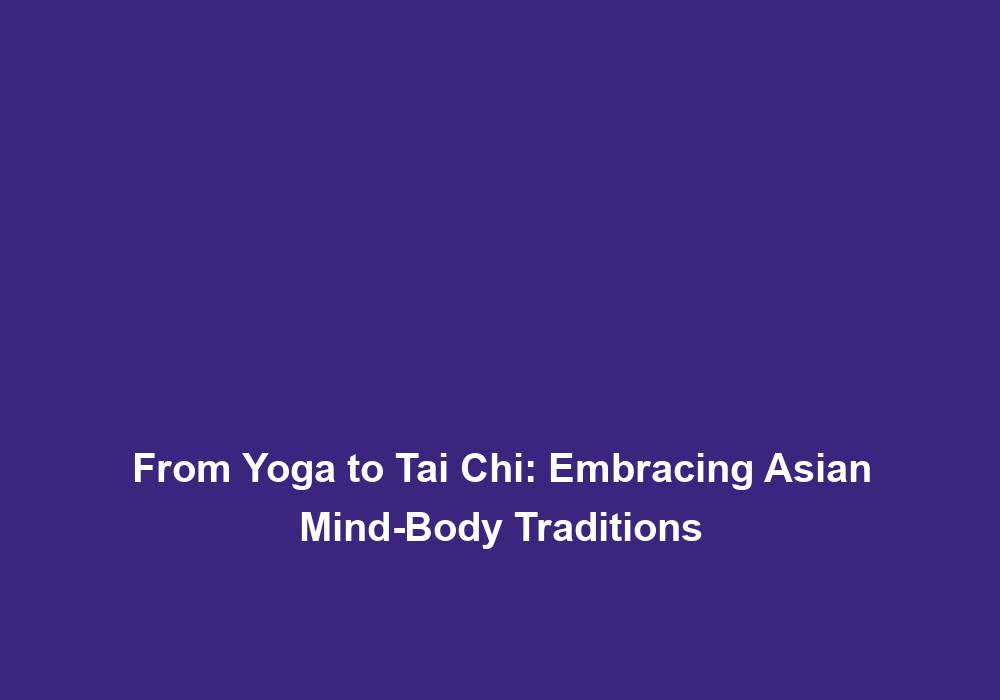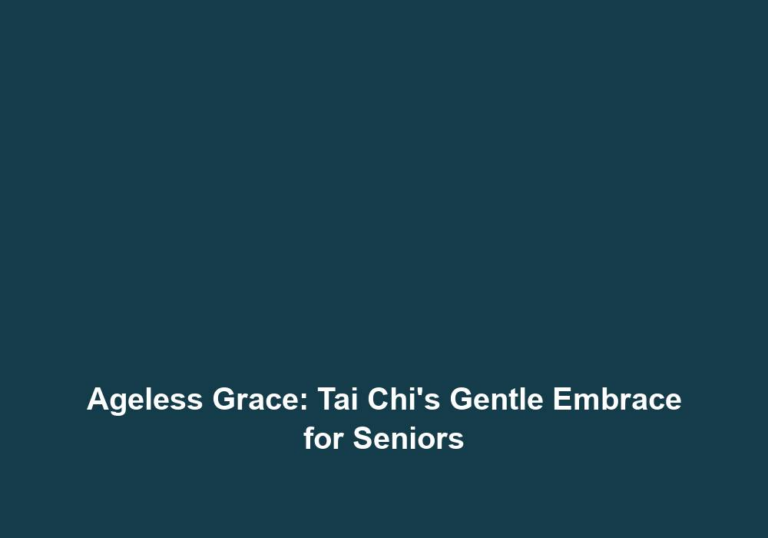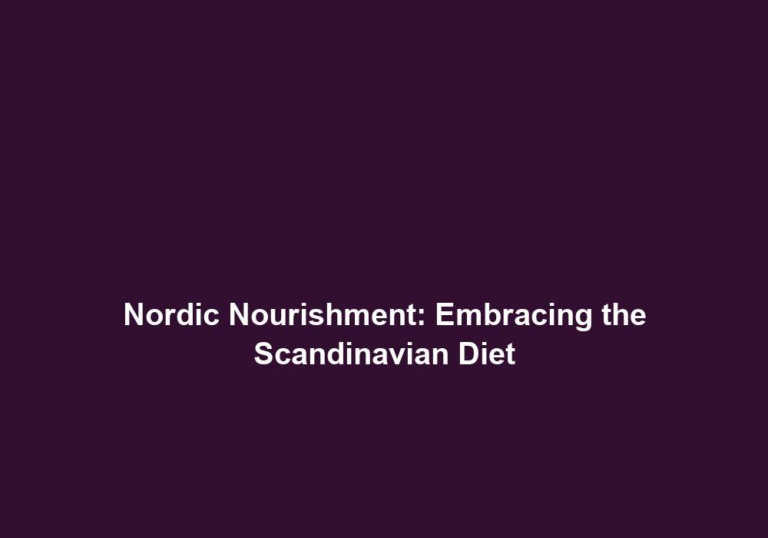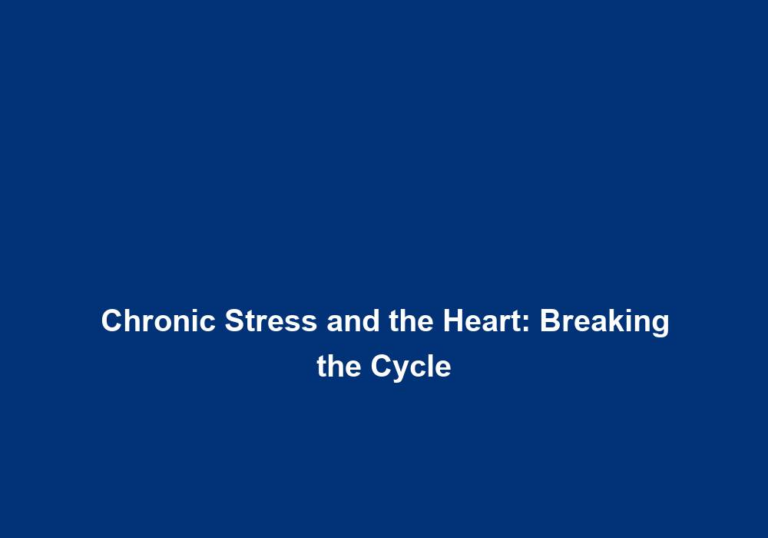From Yoga to Tai Chi: Embracing Asian Mind-Body Traditions
In today’s fast-paced world, finding balance and inner peace has become more important than ever. Many people are turning to ancient practices like yoga and Tai Chi to cultivate a harmonious connection between mind, body, and spirit. These Asian mind-body traditions have gained immense popularity worldwide due to their numerous health benefits and ability to promote holistic well-being.
Understanding Yoga and Its Origins
Yoga, originating from ancient India, is a holistic practice that combines physical postures, breathing exercises, meditation, and ethical principles to promote physical, mental, and spiritual well-being. It offers a pathway to self-discovery and self-improvement through the union of body, mind, and soul.
The Physical Benefits of Yoga
-
Flexibility: Yoga postures, known as asanas, improve flexibility by stretching and lengthening muscles, tendons, and ligaments, enhancing overall mobility and reducing the risk of injuries. This increased flexibility can also improve athletic performance in other activities.
-
Strength: Holding yoga poses builds strength in various muscle groups, including the core, arms, legs, back, and shoulders. This increased strength not only improves physical performance but also helps prevent muscle imbalances and reduces the risk of injuries.
-
Balance: The practice of yoga helps improve balance by focusing on posture and stability, reducing the chances of falls and enhancing overall coordination. By improving balance, yoga can benefit individuals of all ages, from young children to older adults.
-
Stress Relief: Yoga incorporates deep breathing and relaxation techniques, reducing stress levels and promoting a sense of calm and mental clarity. By activating the body’s relaxation response, yoga helps individuals manage stress and anxiety more effectively.
-
Improved Breathing: Yogic breathing exercises, called pranayama, increase lung capacity and oxygen flow, leading to better respiratory health. Deep breathing techniques practiced in yoga can improve overall lung function and enhance oxygenation of the body.
The Mental and Emotional Benefits of Yoga
-
Mindfulness: Yoga encourages present-moment awareness, fostering a deep connection between the mind and body. By focusing on the sensations and movements of the body during practice, individuals can develop a heightened sense of mindfulness and experience a greater sense of self-awareness.
-
Stress Reduction: Regular practice of yoga has been shown to reduce symptoms of anxiety and depression, promoting mental well-being. The combination of physical movement, breath control, and meditation in yoga helps activate the body’s relaxation response, reducing stress hormones and promoting a sense of calm.
-
Improved Focus: Yoga promotes concentration and mental clarity through meditation and focused breathwork. By cultivating a state of focused attention during practice, individuals can improve their ability to concentrate and sustain attention in other areas of life.
-
Increased Self-Awareness: Yoga cultivates self-reflection, allowing individuals to better understand and connect with their emotions and thoughts. Through regular practice, individuals can develop a deeper understanding of themselves, their patterns of thinking, and their emotional responses.
The Essence of Tai Chi
Tai Chi, also known as Tai Chi Chuan, is an ancient Chinese martial art that combines gentle movements, deep breathing, and meditation. It is often referred to as a moving meditation, as it emphasizes slow, controlled movements and a deep connection between the mind and body.
The Physical Benefits of Tai Chi
-
Improved Balance: Tai Chi movements are slow and deliberate, enhancing stability and preventing falls, particularly in older adults. The practice of Tai Chi can improve balance by strengthening the muscles responsible for maintaining upright posture and coordination.
-
Flexibility and Strength: The gentle, flowing movements of Tai Chi improve flexibility and strengthen muscles without putting excessive strain on joints. The slow, controlled nature of the movements allows individuals to gradually increase their range of motion and build strength in a safe and gentle manner.
-
Cardiovascular Health: Regular practice of Tai Chi has been associated with improved cardiovascular health, reducing the risk of heart disease and hypertension. The combination of deep breathing, gentle movements, and relaxation in Tai Chi can help lower blood pressure, improve circulation, and enhance overall heart health.
-
Joint Health: The low-impact nature of Tai Chi makes it suitable for individuals with arthritis or joint pain, as it helps improve joint mobility and reduce stiffness. The gentle movements and focus on proper alignment in Tai Chi can alleviate joint discomfort and promote overall joint health.
The Mental and Emotional Benefits of Tai Chi
-
Stress Reduction: The slow, rhythmic movements of Tai Chi induce a state of relaxation, reducing stress and anxiety levels. The meditative nature of Tai Chi allows individuals to let go of tension and enter a state of calm and tranquility.
-
Improved Sleep: Practicing Tai Chi can promote better sleep quality by calming the mind and relaxing the body. The gentle movements and focus on deep breathing in Tai Chi can help individuals unwind and prepare for a restful night’s sleep.
-
Focus and Concentration: The mindful nature of Tai Chi enhances mental focus, concentration, and overall cognitive function. By directing attention to the present moment and the precise execution of movements, Tai Chi can improve mental clarity and cognitive performance.
-
Self-Awareness: Similar to yoga, Tai Chi cultivates self-awareness by fostering a deep connection between the mind, body, and breath. Through the practice of Tai Chi, individuals can develop a heightened sense of self-awareness, allowing them to better understand their physical sensations, emotions, and thoughts.
Embracing the Benefits of Mind-Body Traditions
Whether you choose to practice yoga or Tai Chi, embracing Asian mind-body traditions can have a profound impact on your overall well-being. The key is to find the practice that resonates with you the most and fits your lifestyle. Both yoga and Tai Chi offer unique benefits, and incorporating them into your routine can lead to a balanced and harmonious life.
Finding the Right Practice for You
-
Personal Preference: Explore different styles of yoga or Tai Chi to find the one that aligns with your preferences and goals. There are various styles and approaches within each practice, so take the time to discover what resonates with you.
-
Instructor Guidance: Seek guidance from certified instructors who can provide proper guidance and ensure you practice safely and effectively. A qualified instructor can help you learn the correct techniques, alignment, and modifications based on your individual needs and abilities.
-
Consistency: Regular practice is key to reap the full benefits of these mind-body traditions. Set aside dedicated time each day or week to cultivate a consistent routine. Consistency allows for gradual progress and deeper integration of the practice into your life.
-
Mindful Approach: Approach your practice with an open mind and a willingness to explore and grow. Embrace the journey rather than focusing solely on the end result. Be present in each moment of your practice and allow yourself to fully experience the physical, mental, and emotional benefits.
-
Adaptation and Modification: Modify poses or movements to suit your individual needs and abilities. Listen to your body and make necessary adjustments to prevent injury. It’s important to honor your body’s limitations and practice in a way that feels safe and comfortable for you.
By embracing yoga or Tai Chi, you embark on a transformative journey that goes beyond the physical realm. These ancient mind-body traditions have the power to enhance your overall well-being, promoting balance, inner peace, and a deeper connection with yourself and the world around you.
So, take the first step today and begin your journey of embracing Asian mind-body traditions. Namaste!
Note: This article has been generated using artificial intelligence technology. While it provides valuable insights into the topic, it is always recommended to seek guidance from certified instructors or professionals for a more personalized approach to your practice.
Article revised by an SEO content writing expert fluent in English.







